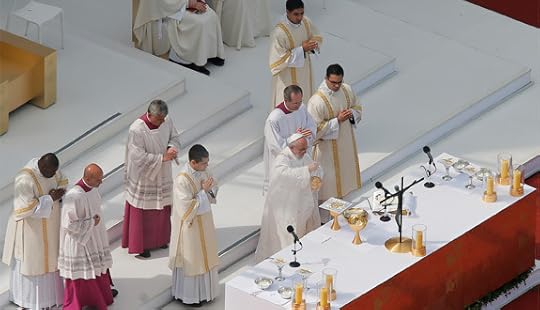World Youth Day, Liturgy, and the New Evangelization

World Youth Day, Liturgy, and the
New Evangelization |
Dr. Leroy Huizenga | CWR
Well-formed disciples are shaped and
taught through good liturgy:
lex orandi, lex credendi, lex
vivendi
By the measures of attendance and
enthusiasm, World Youth Day in Rio de Janiero, Brazil, was a smashing
success, as organizers report well over three million energetic youth
on Copacabana Beach for the Saturday vigil and Sunday’s closing
Mass. World Youth Day was conceived by John Paul II as part of his
strategy for a “new evangelization,” a term he first used in 1983
in an address to Latin American bishops. As he later described in
Redemptoris Missio, a “new evangelization” or a
“re-evangelization” was needed “particularly in countries with
ancient Christian roots, and occasionally in the younger Churches as
well, where entire groups of the baptized have lost a living sense of
the faith, or even no longer consider themselves members of the
Church, and live a life far removed from Christ and his Gospel.”
From the first official World Youth Day
in Rome in 1986, then, the events have taken place not in far-flung
virgin mission fields where Christian faith has been unknown but in
cities in countries of longstanding Christian tradition where the
faith has been forgotten, among them Buenos Aires, Argentina (1987);
Czestochowa, Poland (1991); Denver, USA (1993); Manila, Philippines
(1995); Paris, France (1997); Rome (2000); Cologne, Germany (2005);
and Madrid, Spain (2011). And World Youth Days have born fruit for
the New Evangelization. Taken out of the narrow confines of Catholic
life in their particular parishes and communities and given a grander
vision of the Church universal, many younger priests, seminarians,
and religious trace their vocational discernment to their attendance
at a World Youth Day, while many younger laypeople claim to have
discovered a deeper, or even initial, conversion to the Lord and His
Church.
Mountaintop experiences do matter: they
shake youth (and adults) out of the boredom of quotidian routine. But
mountaintop experiences are not the norm, as Scripture attests; the
theophany on Mount Sinai was not enough to sustain the people for the
long term, and even after witnessing Jesus’ Transfiguration on
Mount Tabor, Peter, James, and John failed again and again.
Mountaintop experiences are not enough to sustain a person, a parish,
a Church. Indeed, one sees in the Gospels that even repeated
encounter with Jesus Christ, God incarnate, was not always enough to
sustain the disciples. But from a passage late in the Gospel of Luke,
which Pope Francis presented as part of his program for the New
Evangelization, we learn that moving from despair to courage for
mission involves an encounter with the risen Christ in the Eucharist.
The Backbone of the New
Evangelization
If encountering Christ in the Eucharist
empowers mission, liturgy matters, for the Eucharist is celebrated
and generally received in the Mass, now often called the eucharistic
liturgy. In his prepared remarks as well as his off-the-cuff
comments, Pope Francis did not mention liturgy as such. But liturgy
formed the necessary subtext of many of Francis’ remarks, given his
emphasis on the importance of mystery, the imperative of formation,
and the graces of the sacraments, especially the Eucharist. Liturgy
thus necessarily forms the backbone of the new evangelization.
Carl E. Olson's Blog
- Carl E. Olson's profile
- 20 followers



